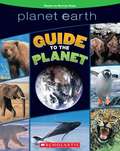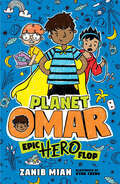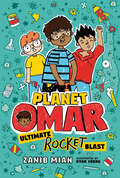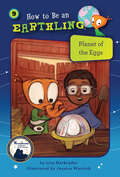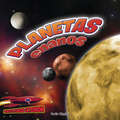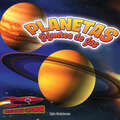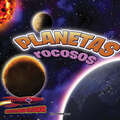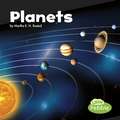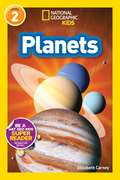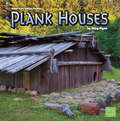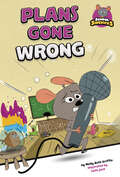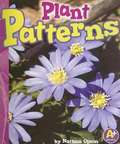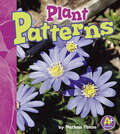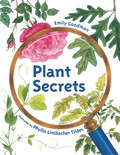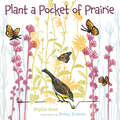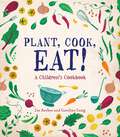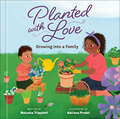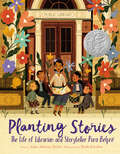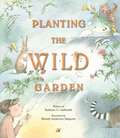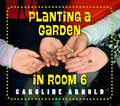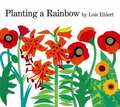- Table View
- List View
Planet Earth: Guide To The Planet
by Steve MurrieAre you ready for the highest, lowest, hottest, coldest, darkest, brightest, wildest, and windiest locations on Earth? They're all here, along with the incredible animals that inhabit them. It's the official guide to your whole world.
Planet Omar: Epic Hero Flop (Planet Omar #4)
by Zanib MianOmar and his friends are up to a new heroic adventure in the fourth installment of this highly-illustrated middle-grade series starring a Muslim boy with a huge imagination.Is there ever a good time to tell a lie? When his best friend Daniel messes up at school, Omar decides to take the blame to save Daniel from getting in trouble—which makes Omar feel like a total hero! Being treated like a hero feels great, so he does it again. But then something more serious happens, and all eyes land on Omar. Uh-oh. The principal is convinced that Omar must have done it. Will he and his friends be able to prove his innocence, or is his good reputation ruined forever?
Planet Omar: Ultimate Rocket Blast (Planet Omar #5)
by Zanib MianThe action-packed fifth installment in the infectiously sweet illustrated middle grade series starring a Muslim boy with a huge imagination.Omar and his friends are blasting off on another adventure—this time at a rocket-building competition. All of his family's Science Sundays prepared Omar to lead his friends on their quest to build the best rocket in their school, sending them to the nationals. But when their rocket is sabotaged, Omar and his friends have to use their expertise in science and mysteries to find the culprit. This fifth book in the charming, warmhearted, and hilarious series about a boy growing up in a close-knit Muslim family, packed with eye-popping artwork by Kyan Cheng, is explosively fun!
Planet of the Eggs: Patience (How to Be an Earthling)
by Lisa HarkraderActing like an Earthling isn&’t easy! Follow the adventures of Spork the alien in the How to Be an Earthling series. Each book covers a different character trait to help kids think about what they say and do. Shhhh, Newton has a secret. He&’s going to bring something special to Farm Day—a brand new baby chick! Or Newton hopes he&’ll have a chick. Spork keeps asking when the egg is going to hatch. He even offers to speed it up. Newton is torn. . . . Why is waiting so hard? Every How to Be an Earthling title includes fun back-of-book activities that build on story themes. (Character trait: Patience)
Planetas enanos: Dwarf Planets: Pluto and the Lesser Planets (Inside Outer Space)
by Nadia HigginsFive and counting! So far, astronomers have discovered five dwarf planets in our solar system. Pluto, which was once thought of as the ninth planet, is today classified as a dwarf planet. This book looks at the current dwarf planets, characteristics, size, and orbital patterns, as well as the three rules scientists follow to characterize these tiny, round space objects. Every day new discoveries are being made. Who knows how many dwarf planets we will find in the future! This book will allow students to understand that patterns in the natural world can be observed, used to describe phenomena, and used as evidence.
Planetas gigantes de gas: Giant Gas Planets: Jupiter, Saturn, Uranus, and Neptune (Inside Outer Space)
by Kyla SteinkrausThe four planets farthest from the Sun are called the gas giants. Jupiter, Saturn, Uranus, and Neptune are different from the other planets in our solar system. They are not solid, but are made of liquids and clouds of gas with gravity pulling it all together into a planet shape. Learn facts about the climate, gases, size, and other quirky things each of the planets possess. This book isn’t filled with hot air! Pull out your telescope and see if you can observe one of these planets. This book will allow students to understand that patterns in the natural world can be observed, used to describe phenomena, and used as evidence.
Planetas rocosos: Rocky Planets: Mercury, Venus, Earth, and Mars (Inside Outer Space)
by Kyla SteinkrausOur solar system is made up of the millions of objects in the sky above us, including the Sun, moon, stars, and planets. This book examines the four planets closest to the Sun, known as the rocky planets. All four planets, Mercury, Venus, Earth, and Mars are described with information about their atmosphere, landscape, orbits, and Fun Facts that give additional information about each of these rocky planets! This book will allow students to use observations of the Sun, moon, and stars to describe patterns that can be predicted.
Planets
by Martha E. H. RustadDiscover the most important facts about the planets. Simple text and out-of-this-world photographs unlock an early reader’s love of science and learning.
Planets (National Geographic Kids Readers #Level 2)
by Elizabeth Carney Laura MarshThis brilliantly illustrated book taps into children's natural curiosity about the vast world of space. This level two reader, written in simple language that is easy for young readers to understand, introduces children to our solar system, including all of the planets and dwarf planets, and lots of fascinating fun facts. <P><P>This reader helps cultivate the explorers of tomorrow! This high-interest, educationally vetted series of beginning readers features the magnificent images of National Geographic, accompanied by texts written by experienced, skilled children's book authors. The inside back cover of the paperback edition is an interactive feature based upon the book. <P><P> Level 1 books reinforce the content of the book with a kinesthetic learning activity. In Level 2 books readers complete a Cloze letter, or fun fill-in, with vocabulary words.
Plank Houses (American Indian Homes Ser.)
by Riley FlynnSome American Indians used wood planks, poles, and beams to build plank houses. Learn all about plank houses, including the tools used to build them and the people who called them home.
Plans Gone Wrong (School Sidekicks Ser.)
by Molly Beth GriffinFour animal friends live in a school. Stella the Mouse, Nico the Toad, Delilah the Spider, and Bo the Parakeet all love every child at school, so they decide to do something nice for the kids. After all, showing your love to your friends can feel really good. Unfortunately, none of their ideas seem to work out. The grownups keep getting in the way!
Plant Growth and Development: Student Investigations
by National Science Resources CenterNIMAC-sourced textbook
Plant Patterns (Finding Patterns Ser.)
by Nathan OlsonSimple text introduce different kinds of plant patterns.
Plant Secrets
by Emily GoodmanYoung scientists will love this nature mystery that reveals the secrets hiding in seeds, plants, flowers, and fruits throughout the life cycle of various flora. Curiosity will bloom in this introduction to botany and primary nature science. Plants come in all shapes and sizes, but they go through the same stages as they grow. Using four common plants, young readers learn about plant structure and life cycle. Simple text and colorful, detailed illustrations show the major phases of plant growth with each stage holding a &“secret&” for curious readers to guess. Back matter offers more information on each plant, as well as greater detail on each stage of growth.
Plant a Kiss
by Amy Krouse RosenthalFrom the beloved New York Times bestselling author of Dear Girl, Amy Krouse Rosenthal, a simple and timeless celebration of the power of love.Little Miss planted a kiss...One small act of love blooms into something bigger and more dazzling than Little Miss could have ever imagined in this epic journey about life, kindness, and giving.Amy Krouse Rosenthal and Peter H. Reynolds team together to share a message of hope and to remind us all of the joys to be gained from being open and unselfish.Plant a Kiss works to spark the imagination of the youngest readers, but it will also resonate with anyone, such as a new graduate, who responds to the power of planting a kiss.
Plant a Pocket of Prairie
by Phyllis RootAuthor Phyllis Root and illustrator Betsy Bowen last explored the vast, boggy peatlands of northern Minnesota in their book Big Belching Bog. Now, in Plant a Pocket of Prairie, Root and Bowen take young readers on a trip to another of Minnesota&’s important ecosystems: the prairie. Once covering almost 40 percent of the United States, native prairie is today one of the most endangered ecosystems in the world. Plant a Pocket of Prairie teaches children how changes in one part of the system affect every other part: when prairie plants are destroyed, the animals who eat those plants and live on or around them are harmed as well. Root shows what happens when we work to restore the prairies, encouraging readers to &“plant a pocket of prairie&” in their own backyards. By growing native prairie plants, children can help re-create food and habitat for the many birds, butterflies, and other animals that depend on them. &“Plant cup plants,&” Root suggests. &“A thirsty chickadee might come to drink from a tiny leaf pool. Plant goldenrod. A Great Plains toad might flick its tongue at goldenrod soldier beetles.&” An easy explanation of the history of the prairie, its endangered status, and how to go about growing prairie plants follows, as well as brief descriptions of all the plants and animals mentioned in the story. With Betsy Bowen&’s beautiful, airy illustrations capturing the feel of an open prairie and all its inhabitants, readers of all ages will be inspired to start planting seeds and watching for the many fascinating animals their plants attract. What a marvelous transformation could take place if we all planted a pocket of prairie!
Plant and Animal Relationships: Investigation Notebook
by The Lawrence Hall of ScienceNIMAC-sourced textbook
Plant, Cook, Eat!: A Children's Cookbook
by Caroline Craig Joe ArcherFor beginners and green-thumbed foodies, this unusually all-inclusive garden-to-kitchen cookbook is part lesson in gardening and part collection of healthy, delicious, kid-friendly recipes.With vibrant photo-illustrations and clearly organized sections, discover how to plant seeds in patio containers, window boxes, or on an allotment; harvest fruits and vegetables; determine which plant parts are edible; spot pests in the garden; and use home-grown crops to cook everything from bean and bacon spaghetti to polenta chips to tomato, feta, and basil pizza."This effort offers budding young gardeners (and their adults) a comprehensive, hands-on guide to gardening and cooking" — Kirkus Reviews STARRED REVIEW
Planted with Love: Growing into a Family
by Natasha TripplettA heartfelt picture book about one child's experience in foster care that reminds all kids that—just like a garden—love from the right source will help them bloom.Lamar has lived in seven homes in three years and has never stayed anywhere long enough to put down roots. As he watches his new foster mom tend to her garden each day, he soon joins her with cautious curiosity. Together, they plant, they weed, they water . . . until one day Lamar's anger and feelings of uncertainty lead him to destroy the garden.But through his foster mother's love and care, Lamar discovers that just like her garden, he is wanted, he is loved, he has been planted, and he will bloom.Written by a licensed social worker, Planted with Love illustrates that a loving home and a loving adult can provide a safe place for any child to grow and thrive.
Planting Stories: The Life of Librarian and Storyteller Pura Belpré
by Anika Aldamuy DeniseRECIPIENT OF THE PURA BELPRÉ HONOR * A Today Show's Best Kids' Books of 2019 * Indie Next List Pick * Junior Library Guild Selection * “An appealing tribute and successful remedy to the lack of titles about the groundbreaking librarian...a must-have for all libraries.” —School Library Journal (starred review)An inspiring picture book biography of storyteller, puppeteer, and New York City’s first Puerto Rican librarian, who championed bilingual literature.When she came to America in 1921, Pura Belpré carried the cuentos folklóricos of her Puerto Rican homeland. Finding a new home at the New York Public Library as a bilingual assistant, she turned her popular retellings into libros and spread story seeds across the land. Today, these seeds have grown into a lush landscape as generations of children and storytellers continue to share her tales and celebrate Pura’s legacy.Brought to colorful life by Paola Escobar’s elegant and exuberant illustrations and Anika Aldamuy Denise’s lyrical text, this gorgeous book is perfect for the pioneers in your life.Informative backmatter and suggested further reading included.A Spanish-language edition, Sembrando historias: Pura Belpré: bibliotecaria y narradora de cuentos, is also available.“Anika Aldamuy Denise’s intimate telling captures the magical, folk-tale feeling of Belpré’s own stories. Her lyrical text, sprinkled like fairy dust with Spanish words, begs to be read aloud, while Paola Escobar’s stylishly detailed and warmly expressive illustrations capture the joy of sharing stories.” —New York Times Book Review
Planting a Garden in Room 6: From Seeds to Salad (Life Cycles in Room 6)
by Caroline ArnoldKindergarteners learn the joys of gardening in this close-up look at how plants grow.A visit to Mrs. Best's classroom is always inspiring! Follow a classroom of real kindergartners as they grow a garden full of healthy vegetables. Joyful photographs show kids planting seeds, tending the seedlings, and harvesting (and eating!) the results. An exciting introduction to the math and science involved in growing a garden. The Life Cycles in Room 6 series follows Mrs. Best&’s real kindergarten class as they help things grow. This photo-illustrated series engages readers with hands-on science in the classroom and beyond.
Planting a Rainbow (Fountas & Pinnell LLI Blue #Level F)
by Lois EhlertA mother and child plant a rainbow of flowers in the family garden.
Plantology: 30 Activities and Observations for Exploring the World of Plants (Young Naturalists)
by Michael Elsohn RossDID YOU KNOW...Scientists believe that mosses, the first plants, may have changed the Earth's climate from hot to cold by removing carbon dioxide from the atmosphere?Many members of the cabbage family release a poison "mustard" gas to fend off grazers?Plants are used in thousands of industries, from low-cost sewage treatment to new medical cures?Young nature enthusiasts will learn these and other fascinating facts about plants in this colorful, interactive resource. Plantology contains fun, kid-friendly discussions and activities to explore many topics—from seeds, roots, and sprouts to plant skeletons, leaves, petals, and fruits. It then goes beyond the basics to delve into the unknown world of common weeds, fascinating plant defense systems, and the countless roles plants play in our lives. With encouragement to "Try This," "Smell It," and "Look For," kids participate in 30 hands-on activities that promote observation and analysis, writing and drawing, math and science, and nature literacy skills. Children will keep a journal, examine and sketch plant structures, start a seed collection, make tasty vegetarian dishes, and more. Readers from any environment will start to notice the plants around them—not just in parks, gardens, and woods but also surrounding the schools, buildings, and sidewalks of their town, and in their own backyards. Useful resources include a glossary of scientific terms, a list of nature organizations and groups, and a teacher's guide to initiate classroom discussion and investigation.
